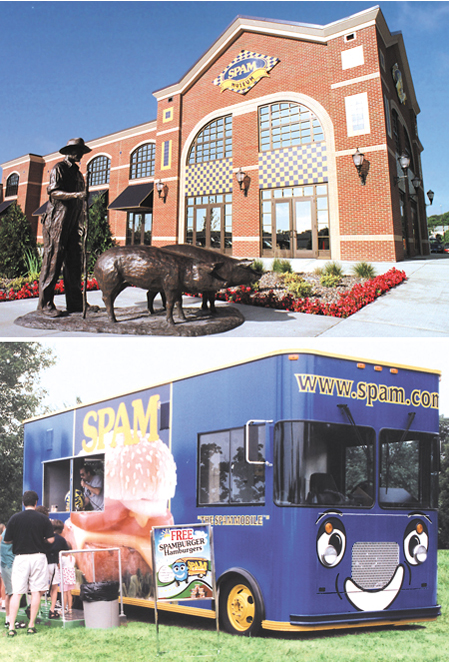Heavy Metal Madness: Spam vs. spam
Although I didn’t follow it here (I don’t believe a trademark should presume journalists will follow capitalization style in conflict with their own style), Hormel prefers the brand Spam® be presented as follows:
- Always put the trademark SPAM in all capital letters.
- Follow SPAM with "Luncheon Meat" or other descriptor. A trademark is a formal adjective and, as such, should be followed by a noun.

The Spam® museum (top) opened in September 2001 and contains more than 16,000 square feet of Spam® memorabilia, including a five-foot replica of a Spam® burger, a rendition of the Monty Python Spam® skit, a wall of Spam® comprised of more than 3,300 cans, and a letter written by President Dwight D. Eisenhower during World War II praising the role Spam® played in feeding Allied forces. The company now also operates three Spam®Mobiles (bottom), which tour the country passing out free miniature Spam® burgers.

A replica of the office of Hormel founder George Hormel, and his son Jay, who is considered the inventor of Spam®. Jay’s son John Hormel of San Francisco was appointed by President Clinton as ambassador to Luxembourg, becoming the first openly gay United States ambassador.
The Power of a Brand Image
Spam® was already the victim of jokes and ridicule before the name turned into slang for junk e-mail (sorry, UCE). But it’s still a big success around the world, with more than 6 billion cans sold. As early as 1940, more than 70% of Americans had eaten Spam® and were familiar with the little blue and yellow can and distinctive logo (which has been “modernized” over the years but kept similar enough that most people wouldn’t notice).
So I guess the lesson learned is to stick with your image and brand, no matter what happens around it. But I have a hunch that if I were christened "Paris Hilton" first, for example, I’d be at the courthouse trying to change my name.
I don’t have any Spam® in my cupboards these days, though with all the turmoil in the world, I’m thinking of buying a few cans and hiding them in the hallway closet. But don’t worry, I don’t own a gun, so if things get tough, come on by for some Spam®wiches.

A frame from the famous Spam®, Spam®, Spam®, Spam® Monty Python skit that indirectly led to spam becoming a slang term for mass, junk emailing. Despite the brand becoming slang for an unpopular activity, Americans still purchase a can of Spam® every 3 seconds, and more than 122 million cans of Spam® are sold each year.
Read more by Gene Gable.


Another British trait is pedantry: Bovril is not a paste supposed to be eaten with a spoon, it is to be mixed with hot water to create a soup or savoury drink. You are perhaps confusing this with Marmite, a gooey yeast-based product, that (arguably) tastes like meat and is spread on bread or toast. (Incidentally Marmite has a great non-changing label, almost the same since 1902, and amusing advertising campaign based on whether you love it or hate it. https://www.marmite.co.uk/)
I’m surprised the country that invented SPAM and various other monstrosities doesn’t import them by the van load!
I appreciate the clarification on Bovril. I had a friend from South Africa who use to eat it by the spoonfull, but I see from further research that she was not in the norm!
Thanks for the comment. A correction will be made as soon as possible.
Gene Gable
A bat of putter,
A sablespoon of peam,
One egg or anutter:
A spamlike dweam.
H.S. Hastings